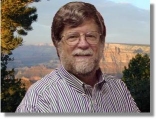|
So here I was, a few short years into the 21st Century and not on the air. The reasons for my twenty year hiatus were rooted in the pain and joy of operating my own business and, frankly, spending nearly 100% of my waking hours with personal computers. Ham Radio took a (far away) back seat.
When we did a remodel on our home in 1998-99, my existing but largely unused 60' tower had to go to make room for an improvement to the deck. But, thinking I might one day get back on the air, I had the foresight to both order a new, freestanding tower and get the hole dug and concrete poured for the base. Just in case. You never know.
I put the tower installation pictures on the 90s page.
But getting the tower installed (which was really more about having a backhoe already on site than anything else) didn't spark enough interest to get back on the air.
2004
It took a lunch in January, 2004 with ham friend Bob Allphin K4UEE to do that. We got to talking about the old days and DXing (Bob is a world-class DXer having operated from dozens of countries, most very, very rare) that got me thinking. I have the radios (they've been in the basement for years) and I have a state-of-the-art tower; all I really need is an antenna and Ham Radio can again be a part of my life.
I asked Bob's advice about a new antenna and he mentioned a relatively new, technically-advanced design for an antenna that covers 6 meters through 20 meters -- and acts as a perfectly tuned monobander on every frequency in between!
Did I mention that I'm a technogeek? The idea of that nifty antenna design just fascinated me. The antenna is the SteppIR made by Fluidmotion -- and I had to have one!!
 Click HERE to read about my installation of the 3-element SteppIR yagi. Click HERE to read about my installation of the 3-element SteppIR yagi.
Remember my Mosley Classic 36 "stored" by the back fence? Still there..wouldn't work on the WARC bands anyhow! (Update: Gary WB4SQ need tubing for an antenna project in the Fall of 2008. He took the Classic 36 parts away..)
Getting back on the air means resurrecting the paperwork for my DXCC position AND it means finding QSL cards to send. I found a few of my old favorite design and did some rework to it. Here 'tis:
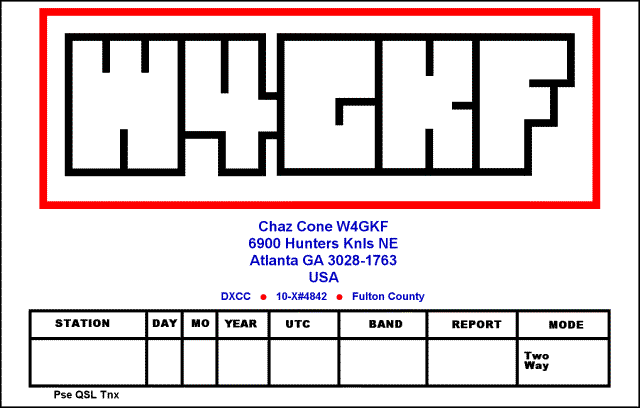
I designed the callsign font myself back in the 70s-80s when I used to be in the QSL card business (as "QSLs Unlimited"). In those days I did cards for the Southeastern DX Club, The Atlanta Radio Club, 10-X International and others. That little business was a major pain and no $$ in it, so I got out of it.
Well, here I am back on the air with this station:
| Icom 765 transceiver |
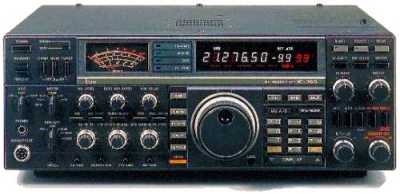 |
| Alpha 78 linear amplifiler |
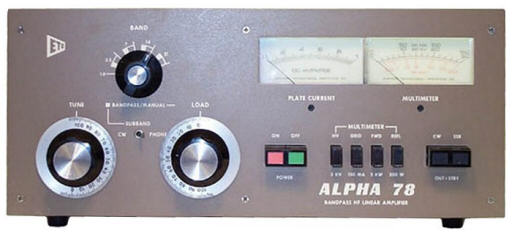 |
| Yaesu G-800DXA rotator |
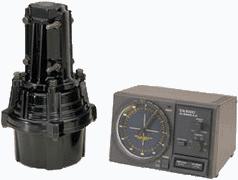 |
| US Tower 72' motor-driven tower |
 |
| SteppIR 3 El yagi antenna |
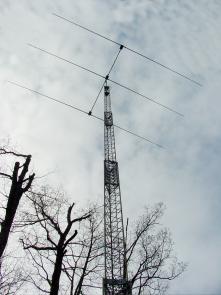 |
Everything's working well and I'm a happy boy. Oh, sure, I'd like to have a fancier radio with a spectrum scope and all, but those things cost $3K and up so, no way.
2005
At last! Another opportunity to use my web development skills in conjunction with Ham Radio!
Ham buddy Bob Allphin K4UEE and his team co-leader Ralph Fedor KØIR had organized the DXpedition of the decade. Twenty-three men were going to Peter I island off the north coast of Antarctica using the callsign 3YØX. The trip was scheduled for January 2005 but logistical problems with the boat and helicopter broke that plan; now they were going January 2006.
Bob asked me to take on the website work. And there was work to do! I spent hundreds of hours on this labor of love (emphasis on "labor") and the DXpedition came off perfectly. I received scores of kudos for the website. It was a genuine pleasure to be involved with this DXpedition -- and I didn't have to get cold!
Read all about it at www.peterone.com.
2006
The first quarter was well-filled with work on the Peter One 3YØX DXpedition; what an event!
And then came the Dayton Hamvention 2006. I rode up to Dayton with Bill Barr N4NX and Dave Johnson K4SSU. A bunch of other SEDXC members were there as well. During the Friday night DX banquet, I just happened to win the top prize! The Icom 756Pro III -- the very same radio I lusted for! I've never won anything big like this before!
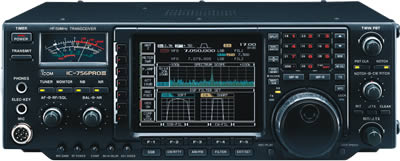
I called Gael and said, "Honey! Guess what! I'm getting a new $3,000 radio!"
She said, "The HELL YOU ARE!!!!"
And then I explained that I won it; she was OK with that.
2007
My club, the Southeastern DX Club SEDXC has occupied most of my ham radio activity this year. Though I didn't get to Dayton this year, I did make it to Huntsville for the Huntsville Hamfest. As hamfests go, Huntsville is one of my favorites:

It's relatively nearby (less than four hours from Atlanta) and it's indoors and air-conditioned; what's not to like?!
I made few purchases at Huntsville. My shopping list was a single item: some kind of 40m antenna.
Since buying my SteppIR in 2004, I've not been on any band below 20meters. But the SEDXC is going to run a contest in October requiring only wire antenna(s). I saw a way to get a 40m antenna and cover the 20, 17, 15, and 10M bands as well. I bought a G5RV Jr.
This nifty wire antenna covers 10-40M and is only 52' long; you can read about it from the company I bought mine from HERE:
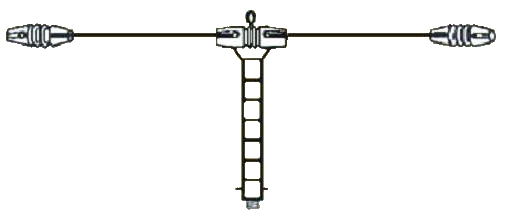
This is what it looks like.
|
From the center of the dipole-like wire drops 17' of 450 ohm twin-lead. It is terminated into an adapter with a SO239. Hook up the 52ohm coax and you're done. The 450 ohm twin-lead converts the match to about 50 ohms. Kewl! |
It seemed like a really good investment of $35.00; of course, that's just the antenna.. I bought 200' of RG8X coax and 500' of small dacron rope and a couple of connector adapters from The Wireman who, conveniently, had a booth nearby. Total investment in the project: ~$200.00.
Now, to put it up.
Our lot is heavily wooded with some 100' hardwoods. There are a lot of them so finding the best place for the antenna would take some planning. I enlisted Bill N4NX to do a site survey with me. While we were thinking about where it would go, we ran the coax into the hamshack (through the PVC pipe installed for just that purpose) and left it coiled up outside. We were pretty sure the antenna would be out in the backyard somewhere.
I haven't put up a wire antenna in decades but I remembered the technique pretty well. You pick out a couple of trees or other supports, get a rope up there (somehow), attach the antenna and haul it up. Easy.
The "getting the rope up there" part presents lots of possibilities. One could climb the trees (NOT!) or propel a line over the tree, attach rope and pull the thing up. The trick? The "propelling" part; getting the line that far above the ground.
Traditionally, I've seen it done with a slingshot, a bow and arrow and a fishing rod -- but recently I heard about a new way. Some hams have come up with a pneumatic antenna launcher that uses compressed air (or CO2) and tennis balls. That's right; tennis balls. You can read all about 'em HERE.
As luck would have it, one our SEDXC club members (and our VP) Bob W2WG owns a part-interest in one of these gizmos. It was easy to persuade Bob to come over and "show me" how it's done. Today (September 5 , 2007) was the day!
I invited Bill N4NX and Bob K4UEE to come help; both were interested in seeing how this launcher thing worked. We began at 10:30a with the crew assembled.
My job? Taking photos, of course!
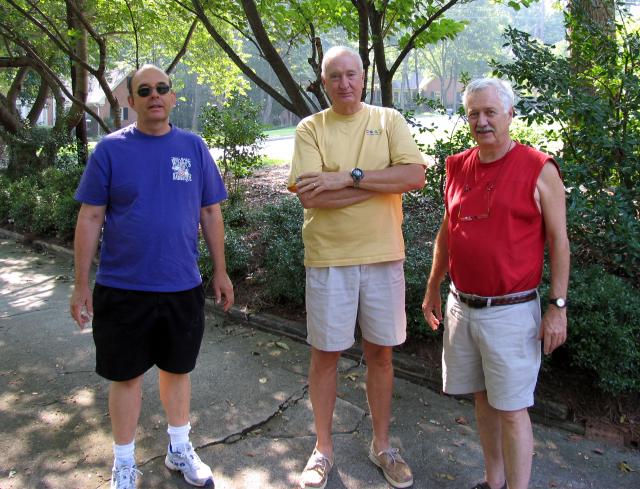
Left-to-right: Bob W2WG, Bob K4UEE and Bill N4NX (no, Bill is not a wife-beater!)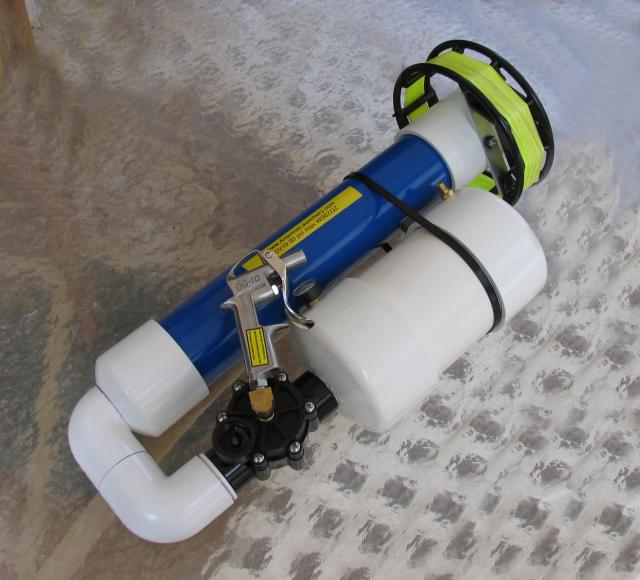
The blue PVC tube holds the tennis ball with the reel of fishing line attached. The larger white tank gets charged with compressed air. The black gizmo began life as a sprinkler valve. You point the large end where you want the ball to go. The trigger releases the air, the tennis ball shoots out the end (whump!) and the line reel releases the line. Simple.
The small brass fitting at the right-end of the tank is where you apply air from a compressor and the small gauge in front of the trigger lets you monitor the amount of air with which you charge the cylinder.
Here's another view:

To create the launcher tennis ball, you poke two small holes in the tennis ball about an inch or so apart and feed a wire between them (with a needle) and fasten the wire into a loop about 3" in diameter. You cut a slot in the ball, drop in 22 pennies and then seal the slot with a glue gun. The finished ball weighs about 4oz (thanks to the pennies).

Attach the fishing line to the loop in the ball, insert the ball into the tube using a ramrod made from smaller PVC tubing. Charge the tank with compressed air (50lbs will shoot the ball nearly 200'), aim and fire. Here's Bob W2WG in firing position:
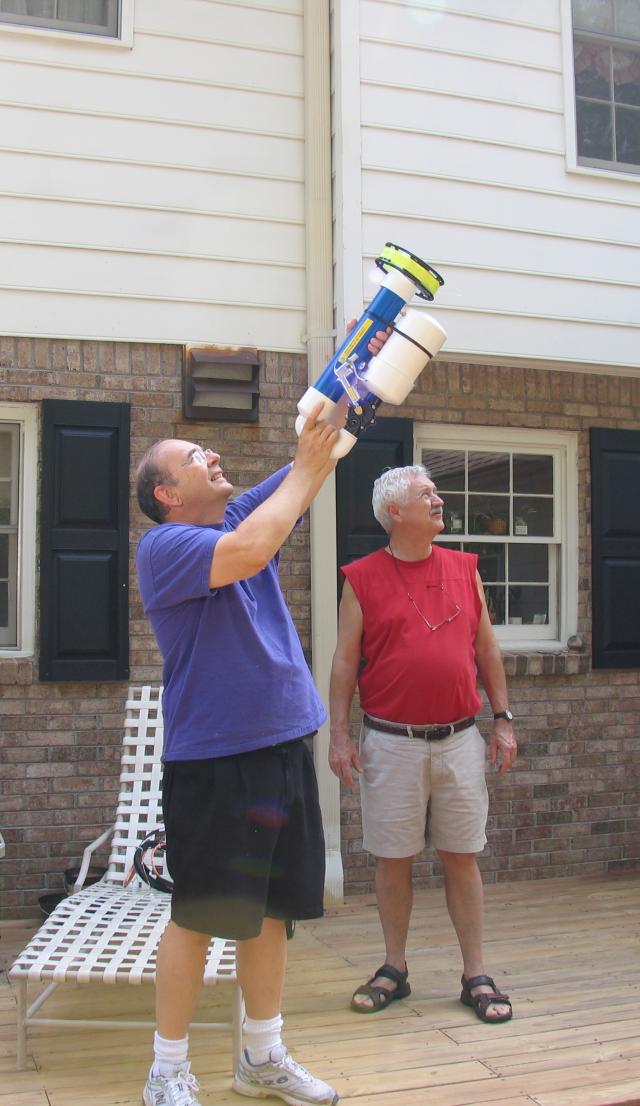 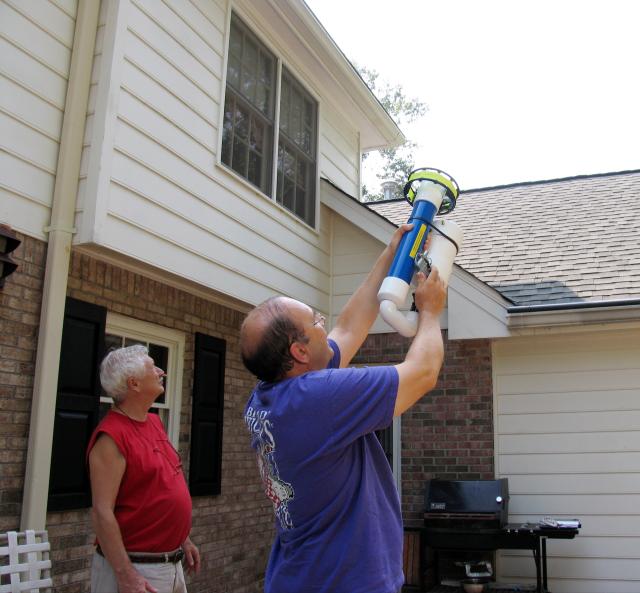 
The ball flies true and up and over a 100' oak tree. Perfect shot! The ball drops the line down to the ground where Bob K4UEE attaches the dacron rope:
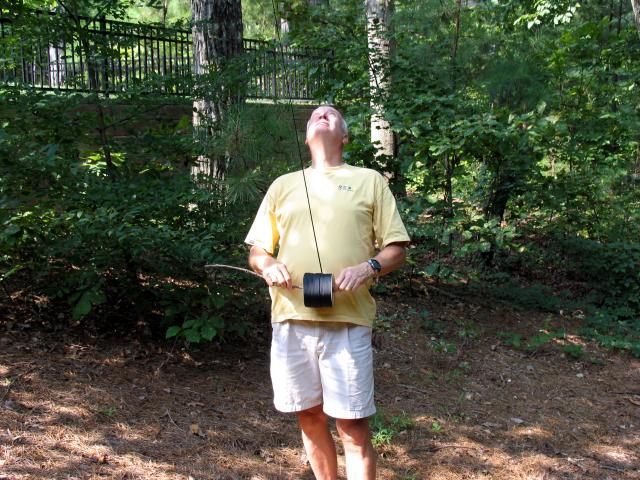 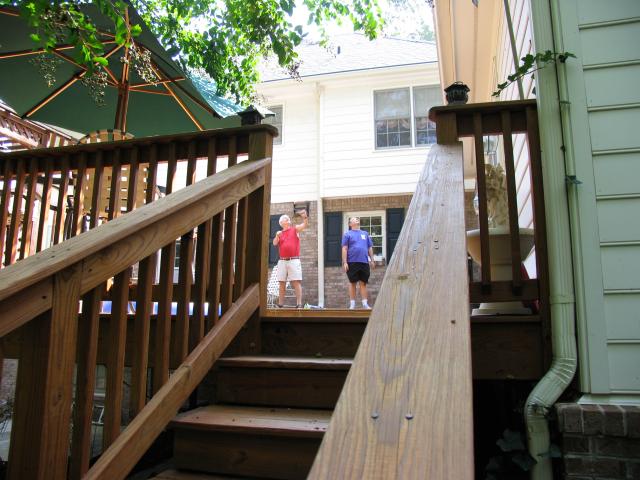
Then, they pass another dacron rope through a small pulley and Bob K4UEE pulls the pulley and doubled pulley rope back to the top of Tree #1 (the South tree). The trees we chose are located such that the antenna will radiate east and west and will be about 65' in the air. Perfect.
In the excitement of the first ball shoot, the crew forgot to wind up the fishing line when pulling the dacron rope down. It took awhile to unsnarl the line:
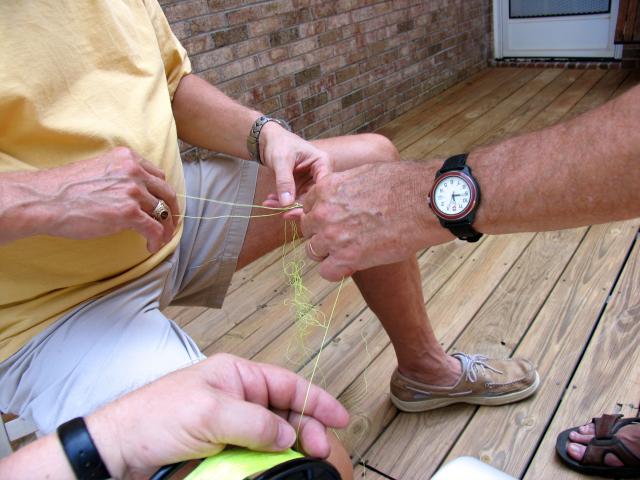 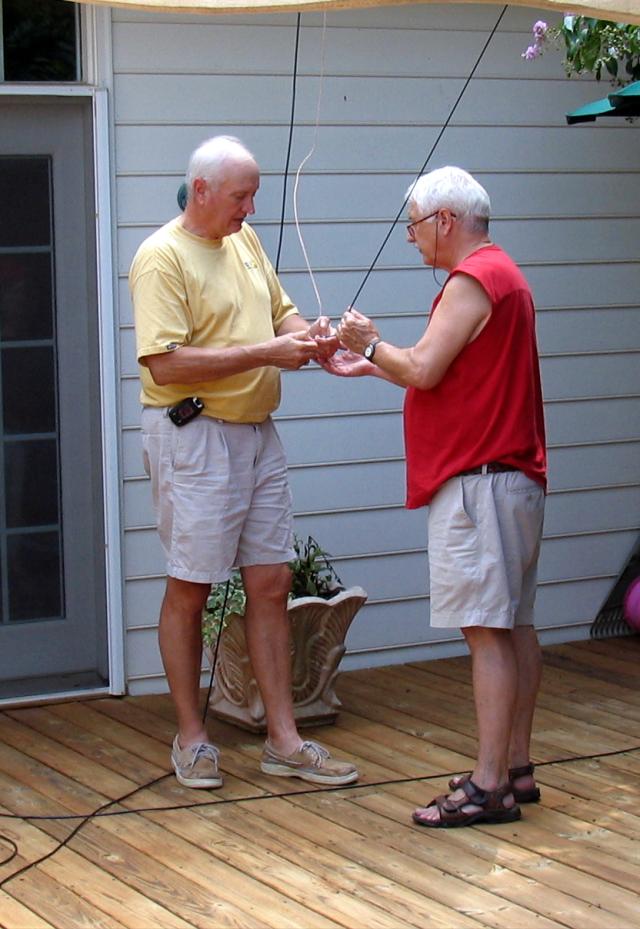
..and repeat for the other tree. Pull 'er up and -- we're done!
Ah, but does it work?
Amazingly well. A tuner is required to get the SWR below 3:1 on most bands, but the built-in tuner in my Icom 756ProIII handled it perfectly. We were able to get a 1:1 match on all bands from end-to-end. We tested all of them and made a few QSOs with great reports.
Later this evening I went to 40m (for the first time since about 1975) and made several QSOs with great results. I'm a happy boy -- and I'm ready for the SEDXC Wire Antenna DX Contest when it kicks off on October 1st!
The rules of the contest were these: You can use any band, any mode, no more than 100W and stationary antennas made of wire. The idea was to show that even a modest station can work DX. I embraced my true love (writing programs in DOS) to create a custom logging program for the contest. Great fun though I didn't win anything. But I did get the winners' plaques made by my old friend Ed Duprey at Great Lakes Trophies and Engraving; and, yes, I do his website, too!
The plaques were give out at the SEDXC Holiday Party and were a big hit:

2008
The SEDXC organized a group to go to Costa Rica for the ARRL DX Phone weekend at the end of February and I got to go; my first contest DXpedition since 1973! The contest occurs the first full weekend of March. Our objective was to win the Multi-Operator - Single-Transmitter award; it turned out we won the Multi-Operator - Multi-Transmitter award; first place in the world!
There were twelve of us on the trip:
- Sam AE4GX
| - Bill N4NX
|
- Randy K4ODL
| - Mike ND4V
|
- Bob K4UEE
| - Chaz W4GKF
|
- Paul KG4UVU
| - Harry W4KJ
|
- George N4GRN
| - Jim W4TE
|
- Don N4HH
| - Gregg W6IXT
|
Here's the QSL I designed for the TI5ØDX DXpedition:

..you can read the whole story HERE.
The Georgia QSO Party is held in April every year. I started competing in it in the SingleOP Low Power Phone category in 2006. This year I was the winner:
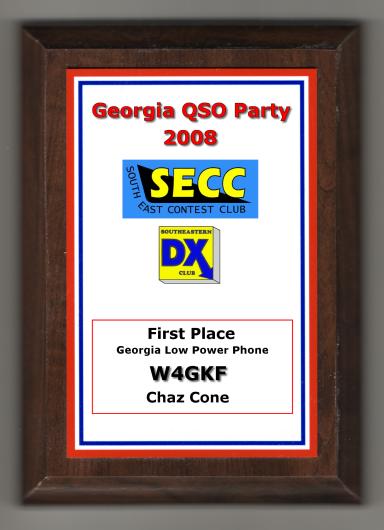
This year the SEDXC celebrated its 50th anniversary with a dinner at Paper Mill Grill. We also commemorated the event by making special QSL card available to members:
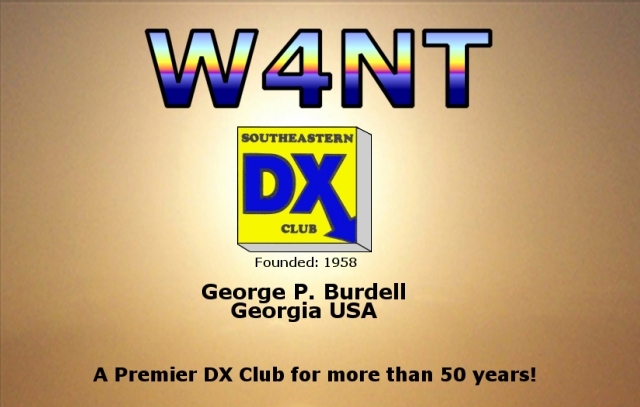
2009
Winning our class in the ARRL Phone DX Contest last year was a great experience -- so why not go for it again this year? We did!
This time the crew went to Curaçao for PJ2T; and we took the wives! Every once in a while we have to include the ladies so they won't complain when we go off on trips like this. The location in Curaçao is about a half-mile away from a resort hotel ("resort" in quotes) so having the ladies come was no problem with them.

Oh; and we won the world -- again!
 Read all about it HERE.
Read all about it HERE.
Also in 2009, Bob K4UEE and his group received permission to activate Desecheo Island located just a few miles off the coast of Puerto Rico. This DXCC entity had no ham radio activity for fifteen years; the US Fish and Wildlife Department prohibited ham operations from there. It took a LOT of political and logistical work to mount a DXpedition there but Bob's team was eventually granted permission to operate from there. He assembled a twenty-two man team divided into two one-week shifts and offered/asked/demanded that I do the website. So I spent a lot of time building the website for K5D Desecheo; read all about it HERE.
2010
After getting beaten by 1500 points last year, I was determined to reclaim the SingleOp, Low Power Phone title this year in the Georgia QSO Party. Apparently last year's winner KT4ZB didn't compete 'cause I won again:
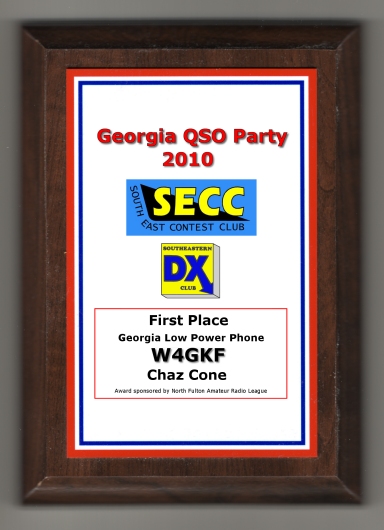
In early spring, Bob K4UEE started talking about a DXpedition to Saba in the Netherlands Antilles.

It seems that several Dutch principalities in the Netherlands Antilles had petitioned for a change in status and the Netherlands was on board with the idea.
At that time, the Netherlands Antilles contained two DXCC entities: Sint Maarten and Curaçao. The proposal was to dissolve the Netherlands Antilles. This would drop the two existing entities and create up to five new ones -- new DXCC entities that no one in the world had credit for; how could we pass that opportunity up?!?
There was a lot of maneuvering and decisions to be made but it wound up that there would be four new entities created on the same day: Sint Maarten, Curaçao, Bonaire and Saba/St. Eustatius. They would all receive DXCC status on the same day, October 10, 2010 (10-10-10!).
Bob chose Saba which, together with nearby St. Eustatius, would be one of the four. He, George N4GRN and Gregg W6IZT made a recon trip there in March and found suitable operating positions so a plan was assembled. Much like the Desecheo trip, we'd have a two-week operation starting October 10 with a crew of nine operators. The team would change out for nine other operators after the first week. Three Week 1 team members stayed for both weeks so there was a total of fifteen guys on the DXPedition.
Here's the QSL Bill N4NX and I designed:
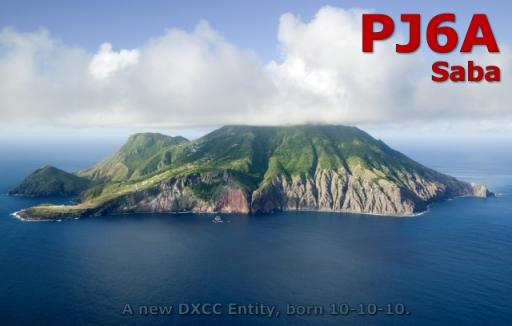
Read all about it HERE.
2011
I was tapped to help out on the website for the VP8ORK DXpedition to South Orkney. I took over from Don N1DG who was on the trip. The site was already underway when I took it over (not my favorite way to work), but you gotta do what you gotta do!
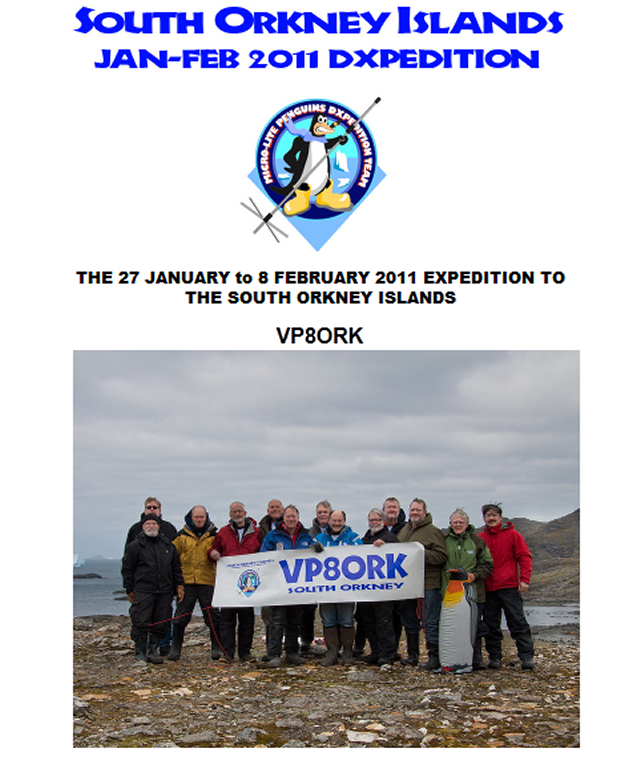 The expedition was extremely successful with 63,643 Qs.
The expedition was extremely successful with 63,643 Qs.
2012
And then things heated up. Bob, K4UEE asked me to be "backup" webmaster for the HKØNA DXpedition to Malpelo Island. He assured me that I'd only have to worry about the "on-island" events.
The webmaster, Pedro HK1X did a really great job:
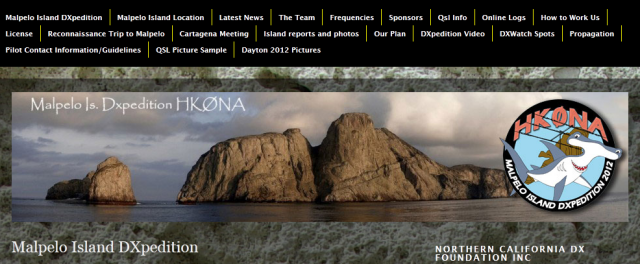 My work was to process "on-island" photos and news and put them up once the team got there:
My work was to process "on-island" photos and news and put them up once the team got there:
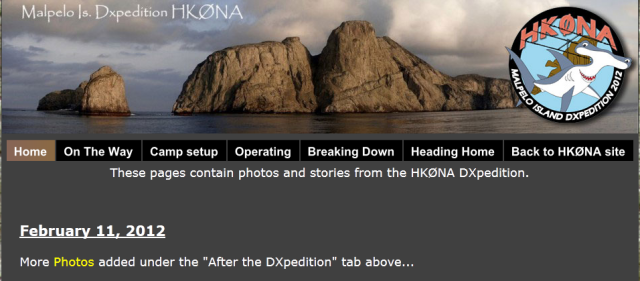 From the images above you can see the subtle differences between my work and Pedro's. It all went very well; the DXpedition scored 195,331 Qs!
From the images above you can see the subtle differences between my work and Pedro's. It all went very well; the DXpedition scored 195,331 Qs!
Later in the year...
I was soundly defeated in the Georgia QSO Party last year (by W4G) so I was determined to take back my Single-Operator, Low Power, Phone title this year.
The North Fulton Amateur Radio Leage (NFARL) is a great club with lots of activities to attract would-be ham operators, get 'em licensed, on the air and introduced to all facets of the ham radio hobby. The club applied to the ARRL for several 1x1 callsigns to use during the GQP this year. The callsigns were K4N, K4F, K4A, K4R and K4L (suffixes spelling out NFARL). There'd be a special certificate for any participants who worked all five stations; cool idea. I asked to be the phone operator for K4R; W5JR would handle K4R for CW.
Another aspect would be to invite NFARL fledgling operators to come to the shack during the contest and see how it worked -- and maybe get a bit of on-the-air-time as well. The Northrops (Bruce KJ4FFP, Laura KJ4ECA, Sarah KK4ATW and Julia (no license yet)) were invited to our home and participated for the full length of the contest (20 hours!):
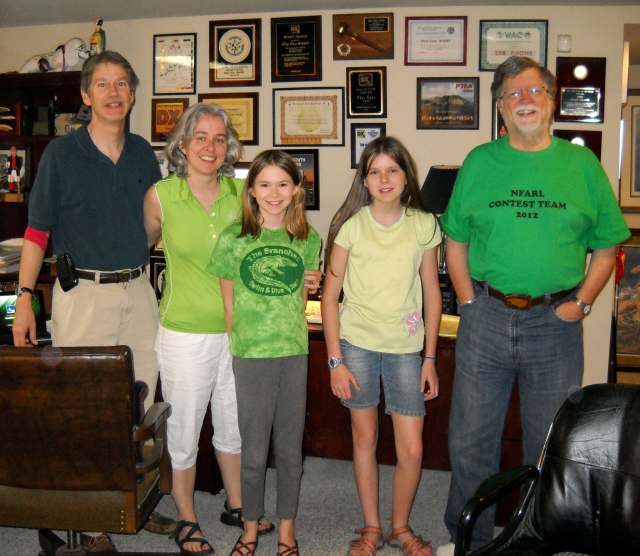 A grand time was had by all, and my score of 50,976 won my category:
A grand time was had by all, and my score of 50,976 won my category:
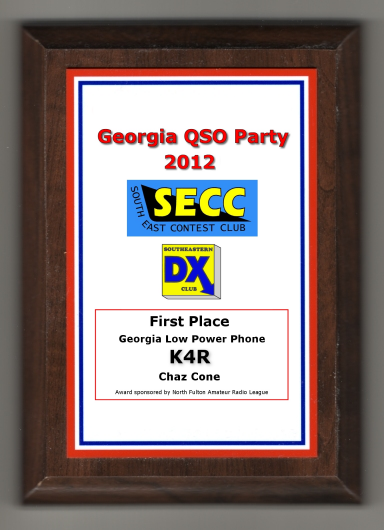 I decided to work on my DXCC credits. Since the hamshack is in the basement and I spend all my time in my office, I installed VE7CC's CC Cluster on my office Win7 PC. This is a great program that lets you tailor the spots you receive to just the countries you need. Plus it allows you to filter out spots made by stations far from you -- so you don't get a spot from say, Montana - which wouldn't be that useful normally to those of us in Georgia.
I decided to work on my DXCC credits. Since the hamshack is in the basement and I spend all my time in my office, I installed VE7CC's CC Cluster on my office Win7 PC. This is a great program that lets you tailor the spots you receive to just the countries you need. Plus it allows you to filter out spots made by stations far from you -- so you don't get a spot from say, Montana - which wouldn't be that useful normally to those of us in Georgia.
I also spent some time figuring out how to link CC Cluster into my logging program DX4Win so that would work as efficiently on the hamshack computer as on the office one. It was a bit arcane figuring that out, so I wrote a paper describing the technique and posted it HERE so others could benefit.
So now, when I'm working and a DXCC entity pops up that I need, CC Cluster tells me. I then run down to the basement hamshack, fire everything up and get into the hunt; works great!
Using this methodology I added these entities to my DXCC worked list just this year:
7O6T, 9K2UU, A5A, AA4VK/CYØ, JX9JKA, OY4TN, P29FR, PJ4/KM3T, TN2T, TO3J, TR8CA, TT8T and ZL9HR
2013
Ham radio has merged, in a way, with my website work. Seems hams want their own websites these days and sometimes turn to me; among them the website for the Georgia QSO Party. In addition to doing the website I was also asked to be the awards manager. The GQP has the best plaque program of any state QSO party. We give out 36 plaques in many categories. Check out www.georgiaqsoparty.com.
In May I discovered an internet system called HamSphere. It is "virtual Ham Radio" or a "ham radio simulator" that works just like the real thing -- except no radios or antennas are needed. It works on the PC, the Mac OS X, Linux and on handheld devices like the iPhone, Android and iPad.
I wanted to try to get my 11yr old grandson interested in ham radio so I introduced him to it; he really seemed to like it -- but when I returned home from California (where he lives) I don't think he used it after that.
I made powerpoint presentations to all the local radio clubs about it. If you live (as many of us do) where ham radio isn't allowed or practical, you can get much of the fun of the hobby (especially workding DX) with HamSphere. Give it a try: www.hamsphere.com.
If you'd like to download my Powerpoint presentation on HamSphere, click HERE.
2014
2015
Watch this space; more to come!
|

